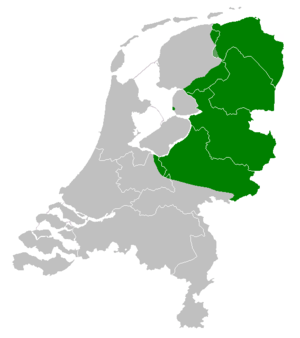West Low German
West Low German, also known as Low Saxon (German: Westniederdeutsch, literally West Low German, or Niedersächsisch (in a stricter sense), literally: Low Saxon, Nether-Saxon; Low German: Nedersassisch, Nedersaksies; Dutch: Nedersaksisch) is a group of Low German (also Low Saxon; German: Plattdeutsch, Niederdeutsch, Dutch: Nederduits) dialects spoken in parts of the Netherlands, northwestern Germany and southern Denmark (in North Schleswig by the German minority). It is one of two groups of mutually intelligible dialects, the other being East Low German dialects. A 2005 study found that there were approximately 1.8 million "daily speakers" of Low Saxon in the Netherlands.[2]
| West Low German | |
|---|---|
| German: Westniederdeutsch | |
| Native to | Germany, Netherlands, Southern Denmark |
Indo-European
| |
| Language codes | |
| ISO 639-2 | nds for Low German |
| ISO 639-3 | Variously:wep – Westphaliannds – (partial)frs – Eastern Frisiangos – Groningsstl – Stellingwerfsdrt – Drentstwd – Twentsact – Achterhoekssdz – Sallandsvel – Veluws |
| Glottolog | west2357[1] |
 Low German area in yellow; Low Saxon dialects are roughly demarcated by the Germany–Netherlands border | |
Extent
The language area comprises the North German states of Lower Saxony, North Rhine-Westphalia (the Westphalian part), Bremen, Hamburg, Schleswig-Holstein and Saxony-Anhalt (the northwestern areas around Magdeburg) as well as the northeast of The Netherlands (i.e. Dutch Low Saxon, spoken in Groningen, Drenthe, Overijssel and northern Gelderland) and the Schleswigsch dialect spoken by the North Schleswig Germans in the southernmost part of Denmark.
In the south the Benrath line and Uerdingen line isoglosses form the border with the area, where West Central German variants of High German are spoken.
List of dialects
Germany
- West Low German
- Westphalian, including the region around Münster and the Osnabrück region of Lower Saxony
- Eastphalian, spoken in southeastern Lower Saxony (Hanover, Braunschweig, Göttingen) and in the Magdeburg Börde region
- Northern Low Saxon
- Schleswigsch[3]
- Holsteinisch[3]
- Ollnborger Platt in the Oldenburg region[3]
- East Frisian Low Saxon in East Frisia[3]
- North Hanoveranian[3]
- Dithmarsch[3]
- Emsländisch[3]

Netherlands
While Dutch is a Low Franconian language, the Dutch Low Saxon varieties, which the Dutch government considers to be Dutch dialects, form a dialect continuum with the Westphalian language. They consist of:
- West Low German
- Westphalian
- Stellingwarfs in southeastern Friesland
- Midden-Drents
- Zuud-Drèents
- Tweants and Tweants-Groafschops in the Twente region of Overijssel and the adjacent Achterhoek region of Gelderland
- Veluws in the Veluwe region of Gelderland
- Gelders-Overijssels
- Northern Low Saxon
- Westphalian
Denmark
- West Low German
- Northern Low Saxon
- Schleswigsch dialect spoken in former South Jutland County (the northern part of the former Duchy of Schleswig) around Aabenraa (Apenrade)
- Northern Low Saxon
References
- Hammarström, Harald; Forkel, Robert; Haspelmath, Martin, eds. (2017). "West Low German". Glottolog 3.0. Jena, Germany: Max Planck Institute for the Science of Human History.
- [Bloemhoff, H. (2005). Taaltelling Nedersaksisch. Een enquête naar het gebruik en de beheersing van het Nedersaksisch in Nederland. Groningen: Sasland.]
- Noble, Cecil A. M. (1983). Modern German dialects. New York [u.a.], Lang, p. 103-104